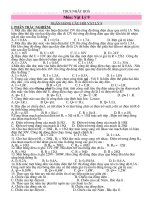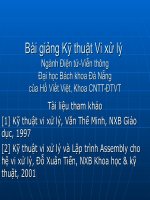PTN SỐ - VI XỬ LÝ
Bạn đang xem bản rút gọn của tài liệu. Xem và tải ngay bản đầy đủ của tài liệu tại đây (82.45 KB, 5 trang )
ECE253: Final Project
Embedded MP3 Player
By:
Arup De (Perm #8730400)
Achutam Murarka(Perm #8730319)
{arup_de, achutammurarka}@umail.ucsb.edu
1. Introduction
MP3 (MPEG 1 layer 3) is a standard for compressing digital audio. It was or developed by the
Moving Picture Experts Group (MPEG). It is one of the dominant and widely used digital formats
today. The use in MP3 of a lossy compression algorithm is designed to greatly reduce the amount of
data required to represent the audio recording and still sound like a faithful reproduction of the
original uncompressed audio for most listeners.
Here in this project we have implemented an MP3 decoder using Spartan 3E Starter kit and an
amplifier from Digilent Inc. on Microblaze processor. Our main implementation on the FPGA
processor is based on the MAD (MPEG Audio Decoder) Player freely available under the GNU
Public License.
2. Design Overview
The block level view of an MP3 decoder is as given below.
Fig 1. Block Level View of an MP3 Decoder
The main stages in the decoding of an MP3 file format is as given below:
1. Synchronizer
2. Huffman Decoding
3. Requantizer
4. Reordering
5. Antialias
6. IMDCT
7. Synthesis Filterbank
2.1 Synchroniser
Frame information is required to know when the given frame ends and when the next from frame
starts. It basically used to derive the information related to the frame correctly. Structure of typical a
frame is as given below.
2.2 Huffman Decoding
Huffman Decoding is an entropy encoding algorithm used for lossless data compression. The
decoding is based on Huffman tables that are used to map the Huffman codes to symbols. Symbols
that occur less frequently are coded with longer Huffman codes and those that occur more frequently
are shorter in length. The output of the Huffman decoder is 576 frequency lines for each granule.
2.3 Requantizer
The decoded sybols obtained from the previous decoding step is then reconstructed into original
frequency lines using the scalefactors in the side information preset in the frame header. These
frequency lines are further sub-divided into 21 divisions called scalefactor bands, each of which has
its own scalefactor.
2.4 Reordering
During the encoding process, the MDCT can arrange the output in two different ways. Normally the
output from the MDCT is sorted by subbands in increasing frequency. When a short block is
decoded, a short window will be used. The output will in this case be sorted on subbands, then on
windows and then on increasing frequency. Reordering is only applied on short blocks, sorting the
frequency lines first by subbands and then by frequency.
2.5 Stereo Processing
Dual channel decoding was used by in the MP3 decoder out the three possible options of single,
dual, stereo options.
2.6 Antialias
Antialias is an attempt for reducing the inevitable alias effects because of using a non- ideal
bandpass filtering in the subband synthesis block of encoder. The alias reconstruction calculation
consists of butterfly calculations for each subband.
2.7 IMDCT
The Inverse Modified Discrete Cosine Transform used in MP3 is an 18-point DCT that produces 36
output values from 18 input values. The equation for IMDCT is as given below.
It does not produce more information than it is provided with, but it disperses the result from the
calculation on a larger number of values. This is why the term modified is being used. The DCT is
inverse because it produces time samples from frequency lines. The transformation from the
frequency domain to the time domain is done in conjunction with the synthesis polyphase filter bank.
Instead of directly producing time samples, the IMDCT generates polyphase filter subband samples
from the input frequency lines. These will later be used for creating time samples. The 36 calculated
values from the IMDCT must be multiplied with a 36-point window before it can be used by the next
step in the decoding process. There are four different window types that can be applied to the output
samples. The window to use is based on the block type, and the block type can be found in the side
information. The reason for generating 36 output values is that the IMDCT uses a 50% overlap. The
lower 18 values are added with the higher 18 values from the previous frame, and used as output.
The higher 18 values are then stored and used the same way when the next frame is being decoded.
2.8 Synthesis Filterbank
It is the last step in the decoding process where 32 PCM samples are produced from 32 subbands. In
the synthesis process, the 32 subband values are transformed to the 64- value V vector using
matrixing. The V vector is pushed into a FIFO which stores the last 16 V vectors. A U vector is
created from the 32 component blocks in the FIFO and a window function D is applied to U to
produce the W vector. The reconstructed PCM samples are obtained from the W vector by
decomposing it into 16 vectors each 32 values in size and summing these vectors.
3. Implementation Details
Our implementation is based on MAD library from [3]. MAD is a high-quality MPEG audio
decoder. It currently supports MPEG-1 and the MPEG-2 extension to lower sampling frequencies, as
well as the de facto MPEG 2.5 format. All three audio layers - Layer I, Layer II, and Layer III (i.e.
MP3) are fully implemented.
MAD has the following special features:
• 24-bit PCM output
• 100% fixed-point (integer) computation
• completely new implementation based on the ISO/IEC standards
• available under the terms of the GNU General Public License (GPL)
The original MAD library has a lot of implementation details relating to title & timing
information(ID3 Decoding) for the MP3 song. Also it contains implementation details for different
layers viz. layer 1, layer 2, layer3. In our embedded version(highly stripped down so as to run it on
the primitive Microblaze processor) all these implementation details relating to layer 1 & 2 have
been removed. Also the ID3 decoding information present in the MP3 file are all neglected. Also
the all the sine and cosine and mathematically computationally intensive have been ported to look-up
tables. We also modified the MAD player code to work on the big-endian architecture of the
Microblaze processor. Many of the computationaly intensive parts of the code were also removed
from the software and implemented as a hardware peripheral on the Spartan 3E FPGA. In spite of
the fact our code was a highly optimized version to run on an embedded platform the code was
extremely large and could not be booted of the on-chip BRAM’s. So we in our implementation here
we run our source off the on-board 64Mbytes SDRAM.
The other things that were also incorporated as peripherals were the SPI bus interface to interface the
on-board 12-bit DAC to the microblaze processor. As an alternative to the inferior quality of sound
that the 12-bit DAC produces since MAD produces 24-bit PCM which results in 50% of the PCM
information being lost while playing of the 12-bit DAC, we implemented a digital PWM signal
based on the PCM information that was used to drive the speakers. But, to our dismay even this
latter implementation did not improve the sound quality drastically because of noise amplication by
the amplifiers of the speaker. A possible solution to this problem could be another band-pass filter to
remove the high frequency noise.
As a third option we are only decoding the MP3 file on the Spartan board and then the raw PCM
data is transferred to a PC via the serial interface. This raw PCM data can then be played on the PC
rather easily. The sound quality in this option was satisfactorily good because of the superior noise
filters in the drivers.
•
Fig 2. Block Level Diagram of the MP3 Decoder Implementation on Spartan 3E Kit
4. Conclusions
Although the Spartan 3e Starter Kit was able to play music after the entire decoding process the
sound produced was not very clear due to the low resolution of the DAC(12-bits). To produce high
quality stereo sound a 16-bit DAc would be much more preferable. The PWM option also did not
produce the desired clarity in sound due to the same problem. However, when the decoded PCM
data was ported back to a laptop and the analog to digital conversion was done using the hardware
available on any standard laptop the the output had the desired quality as the DAC’s used were of
higher resolution.
5. References
• [1] FPGA based Architecture of MP3 Decoding Core for Multimedia Systems, Thuong Le-
Tien, Vu Cao-Tuan, Chien Hoang-Dinh
• [2] A Full Hardware Implementation for an MP3 Decoder Chip using VHDL, Ahmed H.
Abdel-Gawad, Saad F. Abdel-Aziz, et al.
• Implementation of an 18-point IMDCT on FPGA, Huibert J. Lincklaen.
• [3]
• [4]
• [5]









